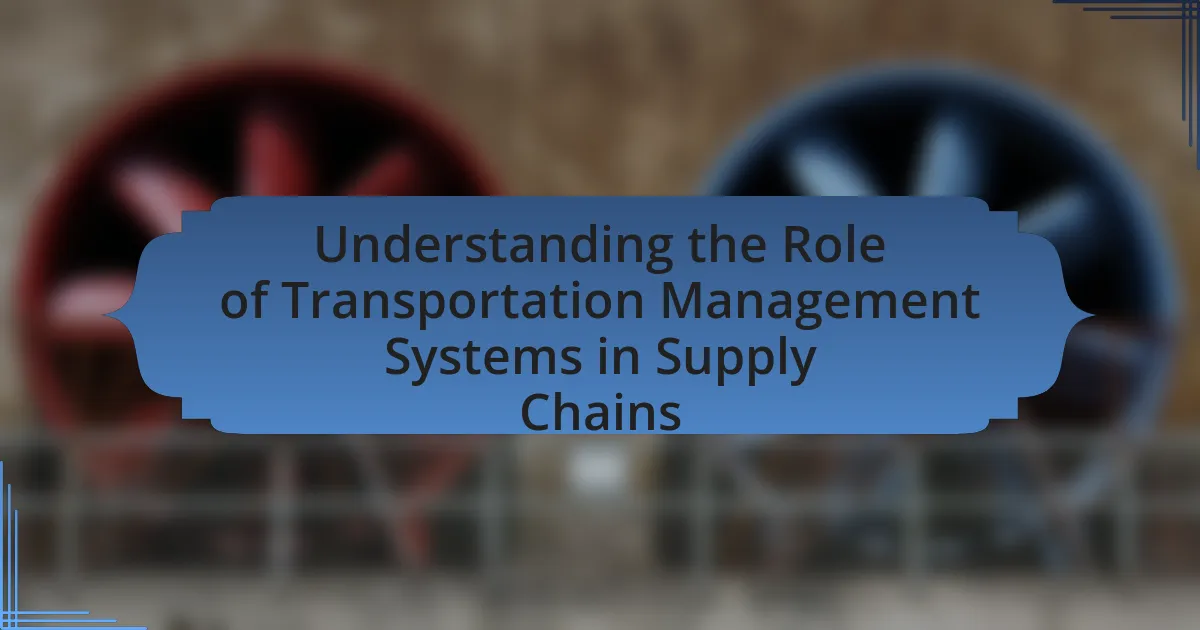The article focuses on the role of artificial intelligence (AI) in enhancing supply chain visibility. It outlines how AI technologies, including machine learning, IoT, and big data analytics, improve real-time data analytics, predictive insights, and overall operational efficiency. Key benefits discussed include reduced logistics costs, improved demand forecasting, and enhanced decision-making capabilities. The article also addresses the challenges organizations face in implementing AI, such as data integration issues and the need for skilled personnel, while highlighting best practices for successful AI integration in supply chain management.
What is the Role of AI in Enhancing Supply Chain Visibility?
AI plays a crucial role in enhancing supply chain visibility by providing real-time data analytics and predictive insights. This technology enables companies to monitor inventory levels, track shipments, and anticipate demand fluctuations, thereby improving decision-making processes. For instance, a study by McKinsey & Company found that organizations leveraging AI in their supply chains can achieve up to a 20% reduction in logistics costs and a 30% increase in service levels. By integrating AI tools, businesses can gain a comprehensive view of their supply chain operations, leading to increased efficiency and responsiveness.
How does AI contribute to supply chain visibility?
AI enhances supply chain visibility by providing real-time data analytics and predictive insights. Through machine learning algorithms, AI processes vast amounts of data from various sources, such as IoT devices and ERP systems, enabling organizations to monitor inventory levels, track shipments, and forecast demand accurately. For instance, a study by McKinsey & Company found that companies using AI in their supply chains can improve forecasting accuracy by up to 50%, leading to better decision-making and reduced operational costs. This capability allows businesses to respond swiftly to disruptions and optimize their supply chain operations effectively.
What technologies are involved in AI-driven supply chain visibility?
AI-driven supply chain visibility involves several key technologies, including machine learning, Internet of Things (IoT), big data analytics, and blockchain. Machine learning algorithms analyze historical data to predict demand and optimize inventory levels. IoT devices collect real-time data from various points in the supply chain, enhancing tracking and monitoring capabilities. Big data analytics processes vast amounts of data to identify trends and improve decision-making. Blockchain technology ensures transparency and security in transactions, enabling trust among supply chain partners. These technologies collectively enhance the efficiency and responsiveness of supply chains.
How do these technologies improve data accuracy and timeliness?
AI technologies improve data accuracy and timeliness by automating data collection and analysis processes, which reduces human error and accelerates decision-making. For instance, machine learning algorithms can analyze vast amounts of supply chain data in real-time, identifying patterns and anomalies that human analysts might miss. This capability allows for quicker adjustments to inventory levels and demand forecasting, leading to more accurate stock management. Additionally, AI-driven predictive analytics can forecast potential disruptions, enabling proactive measures that enhance overall supply chain responsiveness. Studies have shown that companies implementing AI in their supply chains experience up to a 20% increase in data accuracy and a significant reduction in lead times, demonstrating the tangible benefits of these technologies.
Why is supply chain visibility important for businesses?
Supply chain visibility is crucial for businesses because it enables real-time tracking of goods and information throughout the supply chain. This transparency allows companies to respond swiftly to disruptions, optimize inventory levels, and enhance customer satisfaction. According to a study by the Aberdeen Group, organizations with high supply chain visibility experience 93% higher customer satisfaction rates and 50% lower inventory costs. This data underscores the importance of visibility in improving operational efficiency and maintaining competitive advantage.
What challenges do companies face without adequate supply chain visibility?
Companies face significant challenges without adequate supply chain visibility, including increased operational inefficiencies, higher costs, and reduced customer satisfaction. Lack of visibility leads to difficulties in tracking inventory levels, resulting in stockouts or overstock situations, which can increase carrying costs by up to 25%. Furthermore, without real-time data, companies struggle to respond swiftly to disruptions, leading to delays in delivery and potential loss of business. Research indicates that organizations with limited supply chain visibility experience a 20% increase in operational costs due to inefficiencies and miscommunication. Overall, inadequate visibility hampers decision-making and strategic planning, ultimately affecting a company’s competitiveness in the market.
How does enhanced visibility impact decision-making processes?
Enhanced visibility significantly improves decision-making processes by providing real-time data and insights that inform strategic choices. This increased access to information allows decision-makers to identify trends, anticipate issues, and respond proactively. For instance, a study by McKinsey & Company found that companies with high supply chain visibility can reduce inventory costs by 20-50% and improve service levels by 10-20%. Such quantifiable benefits demonstrate that enhanced visibility not only streamlines operations but also leads to more informed and effective decision-making.
What are the key benefits of using AI for supply chain visibility?
The key benefits of using AI for supply chain visibility include enhanced real-time tracking, improved demand forecasting, and increased operational efficiency. AI technologies enable organizations to monitor inventory levels and shipment statuses in real-time, allowing for quicker response to disruptions. For instance, a study by McKinsey & Company found that companies leveraging AI for demand forecasting can achieve up to a 20% reduction in inventory costs. Additionally, AI algorithms analyze historical data to predict future demand patterns, leading to better resource allocation. This integration of AI not only streamlines operations but also enhances decision-making processes, ultimately resulting in a more resilient supply chain.
How does AI improve real-time tracking of goods?
AI improves real-time tracking of goods by utilizing advanced algorithms and data analytics to monitor and predict the movement of products throughout the supply chain. These AI systems analyze data from various sources, such as GPS, RFID, and IoT sensors, to provide accurate location updates and estimated arrival times. For instance, a study by McKinsey & Company highlights that AI can enhance supply chain visibility by up to 30%, enabling companies to respond swiftly to disruptions and optimize inventory management. This capability allows businesses to make informed decisions, reduce delays, and improve overall efficiency in logistics operations.
What role does machine learning play in predictive analytics for supply chains?
Machine learning plays a critical role in predictive analytics for supply chains by enabling the analysis of vast amounts of data to forecast demand, optimize inventory levels, and improve operational efficiency. By employing algorithms that learn from historical data patterns, machine learning models can predict future trends and potential disruptions, allowing supply chain managers to make informed decisions. For instance, a study by McKinsey & Company found that companies using machine learning for demand forecasting can reduce forecasting errors by 20% to 50%, significantly enhancing supply chain responsiveness and reducing costs.
How can AI optimize inventory management through visibility?
AI optimizes inventory management through visibility by providing real-time data analytics and predictive insights. This technology enables businesses to track inventory levels, monitor stock movements, and forecast demand accurately. For instance, a study by McKinsey & Company found that companies using AI-driven analytics can reduce inventory costs by 20-50% while improving service levels. By enhancing visibility, AI allows for better decision-making, reduces stockouts, and minimizes excess inventory, ultimately leading to more efficient supply chain operations.
What cost savings can be achieved through AI-enhanced visibility?
AI-enhanced visibility can achieve significant cost savings by optimizing inventory management and reducing operational inefficiencies. For instance, companies utilizing AI for real-time data analysis can minimize excess inventory by up to 30%, leading to reduced holding costs and waste. Additionally, AI can streamline logistics and transportation processes, resulting in savings of 10-15% on shipping costs through improved route planning and demand forecasting. These efficiencies not only lower direct costs but also enhance overall supply chain responsiveness, contributing to further financial benefits.
How does reducing delays and errors translate to financial benefits?
Reducing delays and errors in supply chain processes directly translates to financial benefits by minimizing operational costs and enhancing efficiency. When delays are reduced, companies can fulfill orders more quickly, leading to increased customer satisfaction and retention, which ultimately boosts revenue. Additionally, fewer errors in inventory management and order processing decrease the costs associated with returns, rework, and lost sales opportunities. For instance, a study by the Aberdeen Group found that companies with optimized supply chains can achieve up to a 20% reduction in operational costs, demonstrating a clear link between improved accuracy and financial performance.
What are the long-term financial impacts of improved supply chain visibility?
Improved supply chain visibility leads to significant long-term financial impacts, including reduced operational costs, enhanced inventory management, and increased revenue through better customer satisfaction. Companies that implement advanced visibility solutions can reduce logistics costs by up to 15% and inventory holding costs by 20%, as evidenced by a study from the Council of Supply Chain Management Professionals. Furthermore, enhanced visibility allows for proactive decision-making, minimizing disruptions and optimizing resource allocation, which can result in a 10-20% increase in overall efficiency. This efficiency translates into higher profit margins and sustained competitive advantage in the market.
What are the challenges of implementing AI in supply chain visibility?
The challenges of implementing AI in supply chain visibility include data integration, lack of skilled personnel, and resistance to change. Data integration is difficult due to disparate systems and formats, which complicates the aggregation of real-time information necessary for effective AI analysis. A report by McKinsey indicates that 70% of organizations struggle with data silos, hindering AI deployment. Additionally, the shortage of skilled personnel proficient in AI technologies limits the ability to develop and maintain these systems. According to a study by the World Economic Forum, 85 million jobs may be displaced by 2025 due to the skills gap in AI and automation. Lastly, resistance to change from employees and management can obstruct the adoption of AI solutions, as organizations often face cultural barriers that impede innovation.
What barriers do organizations face when adopting AI technologies?
Organizations face several barriers when adopting AI technologies, including high implementation costs, lack of skilled personnel, data quality issues, and resistance to change. High implementation costs can deter organizations from investing in AI, as initial expenses for technology and infrastructure can be significant. The lack of skilled personnel is critical, as many organizations struggle to find employees with the necessary expertise in AI and machine learning. Data quality issues arise because AI systems require large amounts of accurate and relevant data to function effectively; poor data can lead to ineffective AI solutions. Lastly, resistance to change within organizational culture can hinder the adoption process, as employees may be reluctant to embrace new technologies and workflows. These barriers collectively impede the successful integration of AI into supply chain visibility initiatives.
How can data quality issues hinder AI implementation?
Data quality issues can significantly hinder AI implementation by leading to inaccurate predictions and suboptimal decision-making. When the data fed into AI systems is incomplete, inconsistent, or erroneous, the algorithms struggle to learn effectively, resulting in flawed models. For instance, a study by IBM found that poor data quality costs organizations an average of $15 million per year, highlighting the financial impact of data inaccuracies. Furthermore, in the context of supply chain visibility, unreliable data can disrupt inventory management and forecasting, ultimately affecting operational efficiency and customer satisfaction.
What are the risks associated with relying on AI for supply chain decisions?
Relying on AI for supply chain decisions carries several risks, including data bias, lack of transparency, and over-reliance on algorithms. Data bias can lead to flawed decision-making if the training data is not representative, resulting in suboptimal outcomes. Lack of transparency in AI algorithms can make it difficult for stakeholders to understand how decisions are made, potentially leading to mistrust and accountability issues. Over-reliance on algorithms may cause organizations to overlook critical human insights and contextual factors, which are essential for effective supply chain management. These risks highlight the importance of integrating human oversight and ensuring data quality in AI applications within supply chains.
How can companies overcome these challenges?
Companies can overcome challenges in enhancing supply chain visibility by implementing AI-driven analytics and real-time data integration. By utilizing AI technologies, companies can analyze vast amounts of data to identify inefficiencies and predict disruptions, leading to more informed decision-making. For instance, a study by McKinsey & Company found that companies using AI in supply chain management can reduce forecasting errors by 50% and improve inventory management by 20%. This data-driven approach enables companies to proactively address issues, streamline operations, and enhance overall supply chain performance.
What best practices should organizations follow for successful AI integration?
Organizations should follow a structured approach for successful AI integration, which includes defining clear objectives, ensuring data quality, fostering cross-functional collaboration, and investing in training. Clear objectives guide the AI implementation process, helping to align technology with business goals. High-quality data is essential, as AI systems rely on accurate and relevant information to function effectively. Cross-functional collaboration among departments enhances the understanding of AI capabilities and promotes a culture of innovation. Additionally, investing in training equips employees with the necessary skills to leverage AI tools, ultimately driving adoption and maximizing the benefits of AI in enhancing supply chain visibility.
How important is employee training in the adoption of AI technologies?
Employee training is crucial in the adoption of AI technologies. Effective training equips employees with the necessary skills to understand, implement, and leverage AI tools, which enhances operational efficiency and decision-making. Research indicates that organizations investing in comprehensive training programs experience a 20% increase in productivity and a 30% improvement in employee engagement. This correlation underscores the significance of training in successfully integrating AI into business processes, particularly in areas like supply chain visibility, where accurate data interpretation and technology utilization are essential for optimizing performance.
What are the future trends in AI and supply chain visibility?
Future trends in AI and supply chain visibility include increased use of predictive analytics, real-time data integration, and enhanced automation. Predictive analytics will enable companies to forecast demand more accurately, reducing excess inventory and improving service levels. Real-time data integration will facilitate seamless communication across the supply chain, allowing for quicker responses to disruptions. Enhanced automation through AI-driven robotics and machine learning will streamline operations, leading to greater efficiency and reduced costs. According to a report by McKinsey, companies that adopt AI in their supply chains can improve their operational performance by up to 20%.
How will advancements in AI technology shape supply chain strategies?
Advancements in AI technology will significantly shape supply chain strategies by enhancing predictive analytics, optimizing inventory management, and improving demand forecasting. AI algorithms can analyze vast amounts of data to identify patterns and trends, enabling companies to anticipate market demands more accurately. For instance, a study by McKinsey & Company found that companies using AI for demand forecasting can reduce forecasting errors by 20-50%, leading to better inventory levels and reduced costs. Additionally, AI-driven automation in logistics can streamline operations, reduce lead times, and improve overall efficiency, further transforming supply chain strategies.
What role will IoT play in enhancing AI-driven supply chain visibility?
IoT will significantly enhance AI-driven supply chain visibility by providing real-time data from connected devices throughout the supply chain. This data enables AI algorithms to analyze and predict supply chain dynamics, improving decision-making and operational efficiency. For instance, IoT sensors can track inventory levels, monitor transportation conditions, and detect equipment malfunctions, allowing AI systems to optimize routes and manage stock levels proactively. According to a report by McKinsey, companies that integrate IoT with AI can achieve up to a 30% reduction in logistics costs and a 20% increase in inventory turnover, demonstrating the tangible benefits of this integration.
What practical steps can businesses take to enhance supply chain visibility with AI?
Businesses can enhance supply chain visibility with AI by implementing real-time data analytics, utilizing predictive analytics for demand forecasting, and integrating AI-driven supply chain management software. Real-time data analytics allows businesses to monitor inventory levels, shipment statuses, and supplier performance continuously, leading to quicker decision-making. Predictive analytics helps in anticipating demand fluctuations, enabling proactive adjustments in inventory and logistics. Furthermore, integrating AI-driven software streamlines communication across the supply chain, ensuring all stakeholders have access to accurate and timely information. According to a report by McKinsey, companies that leverage AI in their supply chains can improve operational efficiency by up to 20%.
How can organizations assess their current supply chain visibility status?
Organizations can assess their current supply chain visibility status by evaluating key performance indicators (KPIs) such as order accuracy, inventory turnover, and lead times. These metrics provide quantifiable insights into how well an organization tracks and manages its supply chain processes. For instance, a study by the Council of Supply Chain Management Professionals indicates that companies with high visibility report a 15% increase in order accuracy and a 20% reduction in lead times. Additionally, organizations can utilize technology solutions like real-time tracking systems and data analytics to identify gaps in visibility and improve decision-making.
What tools and platforms are recommended for improving visibility?
Recommended tools and platforms for improving visibility in supply chains include advanced analytics software, real-time tracking systems, and AI-driven platforms. Advanced analytics software, such as Tableau or Power BI, enables organizations to visualize data trends and make informed decisions. Real-time tracking systems, like RFID technology and GPS tracking, provide immediate insights into inventory and shipment locations. AI-driven platforms, such as IBM Watson Supply Chain and Oracle SCM Cloud, utilize machine learning algorithms to predict disruptions and optimize logistics. These tools collectively enhance visibility by providing actionable insights and facilitating proactive management of supply chain operations.




